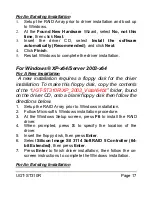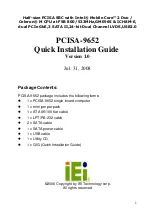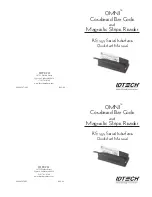
UGT-ST310R Page
7
3.
Select
RAID0
, then press
Enter
.
4.
Select the number of drives then press
Enter
.
5.
Select
Auto configuration
, then press
Enter
.
6.
Input the RAID size, press
Enter
.
7.
When
asked
Are You Sure (Y/N)?
, press
Y
to accept.
8.
Press
Ctrl+E
to exit the BIOS.
9.
When
asked
Are you sure to exit (Y/N)?
, press
Y
to exit
and reboot.
10.
Continue with FDISK and FORMAT steps as if you were
installing a conventional hard drive.
Manual configuration
1.
As the BIOS boots press
Ctrl+S
or
F4
when prompted to
enter the RAID BIOS.
2.
At the next screen select
Create RAID Set
, then press
Enter
.
3.
Select
RAID0
, then press
Enter
.
4.
Select the number of drives then press
Enter
.
5.
Select
Manual configuration
then press
Enter
6.
Select chunk size from
8k
,
16k
,
32k
,
64k
or
128k
, then
press
Enter
.
7.
Select
the
first drive
, press
Enter
.
8.
Select
the
second drive
, press
Enter
.
9.
If applicable select the
3rd
and
4th
drives pressing enter
after each selection.
10.
Input the RAID size, press
Enter.
11.
When
asked
Are You Sure(Y/N)?
, press
Y
to accept.
12.
Press
Ctrl+E
to exit the BIOS.
13.
When asked
Are you sure to exit(Y/N)?
, press
Y
to exit
and reboot.
14.
Continue with FDISK and FORMAT steps as if you were
installing a conventional hard drive.






































